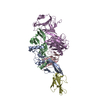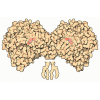[English] 日本語
 Yorodumi
Yorodumi- EMDB-50524: Zebrafish Betaglycan Orphan Domain (zfBGo) in complex with TGF-b1... -
+ Open data
Open data
- Basic information
Basic information
| Entry |  | |||||||||
|---|---|---|---|---|---|---|---|---|---|---|
| Title | Zebrafish Betaglycan Orphan Domain (zfBGo) in complex with TGF-b1 and extracellular domain of TGFBRII | |||||||||
 Map data Map data | Gaussian blurred | |||||||||
 Sample Sample |
| |||||||||
 Keywords Keywords | Complex / Betaglycan / TGFBR3 / TGFb / TGFBR1 / TGFBR2 / MEMBRANE PROTEIN | |||||||||
| Function / homology |  Function and homology information Function and homology informationFGFR1b ligand binding and activation / FGFR1c ligand binding and activation / TGF-beta receptor signaling activates SMADs / TGFBR3 PTM regulation / TGFBR3 regulates TGF-beta signaling / TGFBR3 regulates FGF2 signaling / positive regulation of tolerance induction to self antigen / positive regulation of B cell tolerance induction / inferior endocardial cushion morphogenesis / transforming growth factor beta receptor activity, type II ...FGFR1b ligand binding and activation / FGFR1c ligand binding and activation / TGF-beta receptor signaling activates SMADs / TGFBR3 PTM regulation / TGFBR3 regulates TGF-beta signaling / TGFBR3 regulates FGF2 signaling / positive regulation of tolerance induction to self antigen / positive regulation of B cell tolerance induction / inferior endocardial cushion morphogenesis / transforming growth factor beta receptor activity, type II / bronchus morphogenesis / cellular response to acetaldehyde / frontal suture morphogenesis / mammary gland morphogenesis / Influenza Virus Induced Apoptosis / adaptive immune response based on somatic recombination of immune receptors built from immunoglobulin superfamily domains / positive regulation of microglia differentiation / regulation of interleukin-23 production / branch elongation involved in mammary gland duct branching / positive regulation of primary miRNA processing / lens fiber cell apoptotic process / columnar/cuboidal epithelial cell maturation / growth plate cartilage chondrocyte growth / negative regulation of skeletal muscle tissue development / macrophage derived foam cell differentiation / response to laminar fluid shear stress / embryonic liver development / tricuspid valve morphogenesis / regulation of enamel mineralization / regulation of branching involved in mammary gland duct morphogenesis / regulation of cartilage development / TGFBR2 MSI Frameshift Mutants in Cancer / regulation of striated muscle tissue development / miRNA transport / regulation of blood vessel remodeling / regulation of protein import into nucleus / regulatory T cell differentiation / tolerance induction to self antigen / transforming growth factor beta ligand-receptor complex / extracellular matrix assembly / negative regulation of natural killer cell mediated cytotoxicity directed against tumor cell target / negative regulation of hyaluronan biosynthetic process / type III transforming growth factor beta receptor binding / aorta morphogenesis / myofibroblast differentiation / positive regulation of epithelial to mesenchymal transition involved in endocardial cushion formation / positive regulation of cardiac muscle cell differentiation / positive regulation of odontogenesis / connective tissue replacement involved in inflammatory response wound healing / Langerhans cell differentiation / TGFBR2 Kinase Domain Mutants in Cancer / transforming growth factor beta receptor activity / positive regulation of smooth muscle cell differentiation / positive regulation of exit from mitosis / cardiac left ventricle morphogenesis / regulation of transforming growth factor beta receptor signaling pathway / secondary palate development / negative regulation of macrophage cytokine production / odontoblast differentiation / SMAD2/3 Phosphorylation Motif Mutants in Cancer / TGFBR1 KD Mutants in Cancer / positive regulation of mesenchymal stem cell proliferation / positive regulation of isotype switching to IgA isotypes / positive regulation of receptor signaling pathway via STAT / endocardial cushion fusion / membrane protein intracellular domain proteolysis / positive regulation of extracellular matrix assembly / retina vasculature development in camera-type eye / positive regulation of T cell tolerance induction / heart valve morphogenesis / membranous septum morphogenesis / bronchiole development / positive regulation of NK T cell differentiation / hyaluronan catabolic process / mammary gland branching involved in thelarche / somite development / TGFBR3 regulates TGF-beta signaling / positive regulation of vasculature development / lens fiber cell differentiation / activin receptor complex / activin receptor activity, type I / lung lobe morphogenesis / ATP biosynthetic process / negative regulation of extracellular matrix disassembly / type II transforming growth factor beta receptor binding / receptor catabolic process / transmembrane receptor protein serine/threonine kinase activity / receptor protein serine/threonine kinase / regulation of stem cell proliferation / positive regulation of branching involved in ureteric bud morphogenesis / activin binding / TGFBR1 LBD Mutants in Cancer / SMAD protein signal transduction / positive regulation of chemotaxis / type I transforming growth factor beta receptor binding / response to salt / germ cell migration / positive regulation of mononuclear cell migration / endoderm development / myeloid dendritic cell differentiation Similarity search - Function | |||||||||
| Biological species |  Homo sapiens (human) / Homo sapiens (human) /  | |||||||||
| Method | single particle reconstruction / cryo EM / Resolution: 3.72 Å | |||||||||
 Authors Authors | Wieteska L / Coleman JA / Hinck AP | |||||||||
| Funding support |  United States, European Union, 2 items United States, European Union, 2 items
| |||||||||
 Citation Citation |  Journal: Nat Commun / Year: 2025 Journal: Nat Commun / Year: 2025Title: Structures of TGF-β with betaglycan and signaling receptors reveal mechanisms of complex assembly and signaling. Authors: Łukasz Wieteska / Alexander B Taylor / Emma Punch / Jonathan A Coleman / Isabella O Conway / Yeu-Farn Lin / Chang-Hyeock Byeon / Cynthia S Hinck / Troy Krzysiak / Rieko Ishima / Fernando ...Authors: Łukasz Wieteska / Alexander B Taylor / Emma Punch / Jonathan A Coleman / Isabella O Conway / Yeu-Farn Lin / Chang-Hyeock Byeon / Cynthia S Hinck / Troy Krzysiak / Rieko Ishima / Fernando López-Casillas / Peter Cherepanov / Daniel J Bernard / Caroline S Hill / Andrew P Hinck /     Abstract: Betaglycan (BG) is a transmembrane co-receptor of the transforming growth factor-β (TGF-β) family of signaling ligands. It is essential for embryonic development, tissue homeostasis and fertility ...Betaglycan (BG) is a transmembrane co-receptor of the transforming growth factor-β (TGF-β) family of signaling ligands. It is essential for embryonic development, tissue homeostasis and fertility in adults. It functions by enabling binding of the three TGF-β isoforms to their signaling receptors and is additionally required for inhibin A (InhA) activity. Despite its requirement for the functions of TGF-βs and InhA in vivo, structural information explaining BG ligand selectivity and its mechanism of action is lacking. Here, we determine the structure of TGF-β bound both to BG and the signaling receptors, TGFBR1 and TGFBR2. We identify key regions responsible for ligand engagement, which has revealed binding interfaces that differ from those described for the closely related co-receptor of the TGF-β family, endoglin, thus demonstrating remarkable evolutionary adaptation to enable ligand selectivity. Finally, we provide a structural explanation for the hand-off mechanism underlying TGF-β signal potentiation. | |||||||||
| History |
|
- Structure visualization
Structure visualization
| Supplemental images |
|---|
- Downloads & links
Downloads & links
-EMDB archive
| Map data |  emd_50524.map.gz emd_50524.map.gz | 204 MB |  EMDB map data format EMDB map data format | |
|---|---|---|---|---|
| Header (meta data) |  emd-50524-v30.xml emd-50524-v30.xml emd-50524.xml emd-50524.xml | 25.7 KB 25.7 KB | Display Display |  EMDB header EMDB header |
| FSC (resolution estimation) |  emd_50524_fsc.xml emd_50524_fsc.xml | 14.4 KB | Display |  FSC data file FSC data file |
| Images |  emd_50524.png emd_50524.png | 48.9 KB | ||
| Filedesc metadata |  emd-50524.cif.gz emd-50524.cif.gz | 7 KB | ||
| Others |  emd_50524_additional_1.map.gz emd_50524_additional_1.map.gz emd_50524_additional_2.map.gz emd_50524_additional_2.map.gz emd_50524_half_map_1.map.gz emd_50524_half_map_1.map.gz emd_50524_half_map_2.map.gz emd_50524_half_map_2.map.gz | 107.5 MB 183.5 MB 200.1 MB 200.1 MB | ||
| Archive directory |  http://ftp.pdbj.org/pub/emdb/structures/EMD-50524 http://ftp.pdbj.org/pub/emdb/structures/EMD-50524 ftp://ftp.pdbj.org/pub/emdb/structures/EMD-50524 ftp://ftp.pdbj.org/pub/emdb/structures/EMD-50524 | HTTPS FTP |
-Validation report
| Summary document |  emd_50524_validation.pdf.gz emd_50524_validation.pdf.gz | 1 MB | Display |  EMDB validaton report EMDB validaton report |
|---|---|---|---|---|
| Full document |  emd_50524_full_validation.pdf.gz emd_50524_full_validation.pdf.gz | 1 MB | Display | |
| Data in XML |  emd_50524_validation.xml.gz emd_50524_validation.xml.gz | 21.7 KB | Display | |
| Data in CIF |  emd_50524_validation.cif.gz emd_50524_validation.cif.gz | 28 KB | Display | |
| Arichive directory |  https://ftp.pdbj.org/pub/emdb/validation_reports/EMD-50524 https://ftp.pdbj.org/pub/emdb/validation_reports/EMD-50524 ftp://ftp.pdbj.org/pub/emdb/validation_reports/EMD-50524 ftp://ftp.pdbj.org/pub/emdb/validation_reports/EMD-50524 | HTTPS FTP |
-Related structure data
| Related structure data |  9fkpMC  8dc0C  9b9fC  9fdyC  9fk5C C: citing same article ( M: atomic model generated by this map |
|---|---|
| Similar structure data | Similarity search - Function & homology  F&H Search F&H Search |
- Links
Links
| EMDB pages |  EMDB (EBI/PDBe) / EMDB (EBI/PDBe) /  EMDataResource EMDataResource |
|---|---|
| Related items in Molecule of the Month |
- Map
Map
| File |  Download / File: emd_50524.map.gz / Format: CCP4 / Size: 216 MB / Type: IMAGE STORED AS FLOATING POINT NUMBER (4 BYTES) Download / File: emd_50524.map.gz / Format: CCP4 / Size: 216 MB / Type: IMAGE STORED AS FLOATING POINT NUMBER (4 BYTES) | ||||||||||||||||||||||||||||||||||||
|---|---|---|---|---|---|---|---|---|---|---|---|---|---|---|---|---|---|---|---|---|---|---|---|---|---|---|---|---|---|---|---|---|---|---|---|---|---|
| Annotation | Gaussian blurred | ||||||||||||||||||||||||||||||||||||
| Projections & slices | Image control
Images are generated by Spider. | ||||||||||||||||||||||||||||||||||||
| Voxel size | X=Y=Z: 0.72 Å | ||||||||||||||||||||||||||||||||||||
| Density |
| ||||||||||||||||||||||||||||||||||||
| Symmetry | Space group: 1 | ||||||||||||||||||||||||||||||||||||
| Details | EMDB XML:
|
-Supplemental data
-Additional map: unsharpened map
| File | emd_50524_additional_1.map | ||||||||||||
|---|---|---|---|---|---|---|---|---|---|---|---|---|---|
| Annotation | unsharpened map | ||||||||||||
| Projections & Slices |
| ||||||||||||
| Density Histograms |
-Additional map: EMReady enhanced
| File | emd_50524_additional_2.map | ||||||||||||
|---|---|---|---|---|---|---|---|---|---|---|---|---|---|
| Annotation | EMReady enhanced | ||||||||||||
| Projections & Slices |
| ||||||||||||
| Density Histograms |
-Half map: half map
| File | emd_50524_half_map_1.map | ||||||||||||
|---|---|---|---|---|---|---|---|---|---|---|---|---|---|
| Annotation | half map | ||||||||||||
| Projections & Slices |
| ||||||||||||
| Density Histograms |
-Half map: half map
| File | emd_50524_half_map_2.map | ||||||||||||
|---|---|---|---|---|---|---|---|---|---|---|---|---|---|
| Annotation | half map | ||||||||||||
| Projections & Slices |
| ||||||||||||
| Density Histograms |
- Sample components
Sample components
-Entire : Quinary complex of Zebrafish Betaglycan Orphan Domain (zfBGo) in ...
| Entire | Name: Quinary complex of Zebrafish Betaglycan Orphan Domain (zfBGo) in complex with TGF-B1 and extracellular domains of TGFBRII |
|---|---|
| Components |
|
-Supramolecule #1: Quinary complex of Zebrafish Betaglycan Orphan Domain (zfBGo) in ...
| Supramolecule | Name: Quinary complex of Zebrafish Betaglycan Orphan Domain (zfBGo) in complex with TGF-B1 and extracellular domains of TGFBRII type: complex / ID: 1 / Parent: 0 / Macromolecule list: all |
|---|---|
| Source (natural) | Organism:  Homo sapiens (human) Homo sapiens (human) |
| Molecular weight | Theoretical: 90 KDa |
-Supramolecule #2: Zebrafish Betaglycan - Orphan domain
| Supramolecule | Name: Zebrafish Betaglycan - Orphan domain / type: complex / ID: 2 / Parent: 1 / Macromolecule list: #3 |
|---|---|
| Source (natural) | Organism:  |
-Supramolecule #3: complex part - TGF-B1 and extracellular domains TGFBRII
| Supramolecule | Name: complex part - TGF-B1 and extracellular domains TGFBRII type: complex / ID: 3 / Parent: 1 / Macromolecule list: #1-#2 |
|---|---|
| Source (natural) | Organism:  Homo sapiens (human) Homo sapiens (human) |
-Macromolecule #1: Transforming growth factor beta-1
| Macromolecule | Name: Transforming growth factor beta-1 / type: protein_or_peptide / ID: 1 / Number of copies: 2 / Enantiomer: LEVO |
|---|---|
| Source (natural) | Organism:  Homo sapiens (human) Homo sapiens (human) |
| Molecular weight | Theoretical: 12.809812 KDa |
| Recombinant expression | Organism:  |
| Sequence | String: ALDTNYCFSS TEKNCCVRQL YIDFRKDLGW KWIHEPKGYH ANFCLGPCPY IWSLDTQYSK VLALYNQHNP GASAAPCCVP QALEPLPIV YYVGRKPKVE QLSNMIVRSC KCS UniProtKB: Transforming growth factor beta-1 proprotein |
-Macromolecule #2: TGF-beta receptor type-2
| Macromolecule | Name: TGF-beta receptor type-2 / type: protein_or_peptide / ID: 2 / Number of copies: 2 / Enantiomer: LEVO / EC number: receptor protein serine/threonine kinase |
|---|---|
| Source (natural) | Organism:  Homo sapiens (human) Homo sapiens (human) |
| Molecular weight | Theoretical: 12.926812 KDa |
| Recombinant expression | Organism:  |
| Sequence | String: MNGAVKFPQL CKFCDVRFST CDNQKSCMSN CSITSICEKP QEVCVAVWRK NDENITLETV CHDPKLPYHD FILEDAASPK CIMKEKKKP GETFFMCSCS SDECNDNIIF SEEY UniProtKB: TGF-beta receptor type-2 |
-Macromolecule #3: Transforming growth factor beta receptor III
| Macromolecule | Name: Transforming growth factor beta receptor III / type: protein_or_peptide / ID: 3 / Number of copies: 1 / Enantiomer: LEVO |
|---|---|
| Source (natural) | Organism:  |
| Molecular weight | Theoretical: 37.727 KDa |
| Recombinant expression | Organism:  Homo sapiens (human) Homo sapiens (human) |
| Sequence | String: GSPCELLPVG VGHPVQAMLK SFTALSGCAS RGTTSHPQEV HIINLRKGSA QGAREKTAEV ALHLRPIQSL HVHQKPLVFI LNSPQPILW KVRTEKLAPG VKRIFHVVEG SEVHFEVGNF SKSGEVKVET LPHGNEHLLN WAHHRYTAVT SFSELRMAHD I YIKVGEDP ...String: GSPCELLPVG VGHPVQAMLK SFTALSGCAS RGTTSHPQEV HIINLRKGSA QGAREKTAEV ALHLRPIQSL HVHQKPLVFI LNSPQPILW KVRTEKLAPG VKRIFHVVEG SEVHFEVGNF SKSGEVKVET LPHGNEHLLN WAHHRYTAVT SFSELRMAHD I YIKVGEDP VFSETCKIDN KFLSLNYLAS YIEPQPSTGC VLSGPDHEQE VHIIELQAPN SSSAFQVDVI VDLRPLDGDI PL HRDVVLL LKGEKSVNWV IKAHKVMGKL EIMTSDTVSL SEDTERLMQV SKTVKQKLPA GSQALIQWAE ENGFNPVTSY TNT PVANHF NLRLREHHHH HH UniProtKB: Transforming growth factor beta receptor III |
-Experimental details
-Structure determination
| Method | cryo EM |
|---|---|
 Processing Processing | single particle reconstruction |
| Aggregation state | particle |
- Sample preparation
Sample preparation
| Concentration | 0.3 mg/mL | |||||||||
|---|---|---|---|---|---|---|---|---|---|---|
| Buffer | pH: 7.4 Component:
| |||||||||
| Grid | Model: UltrAuFoil R1.2/1.3 / Material: GOLD / Support film - Material: GOLD / Support film - topology: HOLEY ARRAY / Pretreatment - Type: GLOW DISCHARGE | |||||||||
| Vitrification | Cryogen name: ETHANE / Chamber humidity: 100 % / Chamber temperature: 298 K / Instrument: FEI VITROBOT MARK IV |
- Electron microscopy
Electron microscopy
| Microscope | TFS KRIOS |
|---|---|
| Image recording | Film or detector model: FEI FALCON IV (4k x 4k) / Average electron dose: 45.0 e/Å2 |
| Electron beam | Acceleration voltage: 300 kV / Electron source:  FIELD EMISSION GUN FIELD EMISSION GUN |
| Electron optics | Illumination mode: FLOOD BEAM / Imaging mode: BRIGHT FIELD / Nominal defocus max: 2.5 µm / Nominal defocus min: 0.75 µm |
| Experimental equipment |  Model: Titan Krios / Image courtesy: FEI Company |
 Movie
Movie Controller
Controller



















 Z (Sec.)
Z (Sec.) Y (Row.)
Y (Row.) X (Col.)
X (Col.)





















































